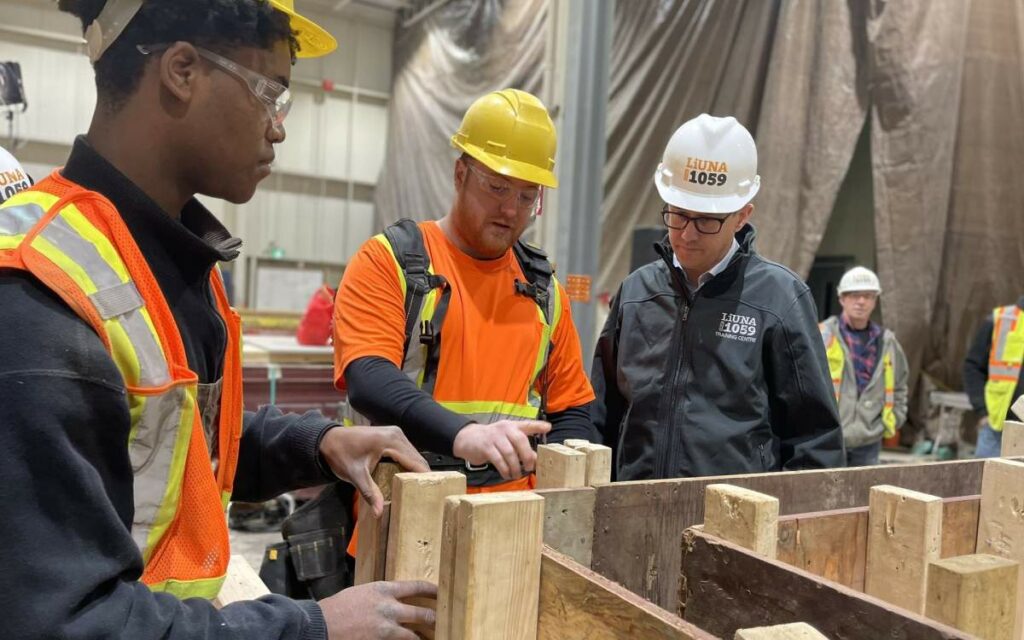
There’s no question that updated and expanded training for and increased promotion of the skilled trades in Ontario were long-overdue. However, the province’s pendulum swing in focus over the last four-plus years has caused many traditional institutions of higher education to fall behind in a big way. Pictured is Minister of Labour, Immigration, Training and Skills Development Monte McNaughton (right). Photo credit: Twitter/Monte McNaughton
In the world of public policy, there is “the law of unintended consequences”. It means that whenever a government tries to fix one problem, it inevitably creates other unintended problems, as bad or sometimes even worse than the original problem it was trying to fix in the first place.
Such a phrase describes the Ontario Government’s current approach to post-secondary education. While Premier Doug Ford and his Labour Minister Monte McNaughton deserve kudos for recognizing and trying to fix the lack of skilled trades in the economy, the “fix” is creating equally serious problems in the rest of the post-secondary world.
For example, this spring’s provincial budget provided $224 million dollars for new and up-graded employment and training centres for skilled trades. The money will go to labour groups, Indigenous centres, business and industry organizations.
All well and good, but none of it goes to the 24 community colleges that already play a dominant and successful role in skills training, including delivering over 80 per cent of the in-class portion of apprenticeship training.
Expanding the number of training providers could be a worthy goal. But what about expanding the current infrastructure too? The college system has been a strong provider of employment-ready workers, but its facilities are in great need of capital investments as well.
In addition, colleges, like universities, in a time of high inflation, are also struggling to absorb a series of funding cuts imposed by the government. First was the 10 per cent cut in student tuition fees – popular with students and their parents, but a major problem for the institutions because there was no increased funding to compensate the sector for the revenue loss. This decision has now been followed by a three-year freeze with no immediate end in sight.
One can understand the political attraction of reducing student tuition fees for families, but what about the unintended consequences for the sector’s financial sustainability?
The sector has already had one casualty – the near bankruptcy of Laurentian University (although, it must be noted that bad financial management by its administration was also at fault.)
Still, many other post-secondary institutions are struggling with serious financial challenges, a situation the government is well-aware of. Unfortunately, it has responded by freezing overall grants yet again this year. To make matters worse, the government has also capped the number of students it will fund, forcing institutions to rely more and more heavily on international students to try and make up the growing revenue gap. In the words of one Toronto journalist, “freezes, cuts and caps…(is)…perpetuating a hollowing out of higher education” in the province.
And all this at a time when the provincial government is aggressively courting foreign investors in advanced manufacturing with the promise of one of the best skilled and educated talent pools in the world.
Raw politics, as always, is part of the picture. The government’s support for expanding skilled trades is paying off in increased political support from private sector unions while parents are highly unlikely to vote for higher student tuition.
And universities, despite the statistics about the economic success of their graduates, still suffer from the perception that they are elite, ivory tower bureaucracies making them highly unlikely to attract the love of a government that prides itself on its populist credentials.
But the unintended consequences of their approach require careful thought by the Premier, his Labour Minister and his Minister of Colleges and Universities, Jill Dunlop.
Ontario does indeed have a highly skilled and educated workforce and it is proving a valuable incentive to attract new investments and jobs. But as technology advances, more and more skilled trades jobs require education beyond the critical practical skills. And today’s economy puts a premium on a system that needs to be capable of supporting life-long learning for its workforce.
Changes are certainly needed in the post-secondary world. And the government’s recent appointment of its so-called “blue ribbon panel” to recommend solutions signals that they recognize the need.
The trick, however, will be to stay focused on the important objective – a financially sustainable post-secondary system that is capable of producing educated, employment ready students who can succeed in an increasingly high-tech economy. And watch out for those unintended consequences.

Janet Ecker is a former Ontario Finance Minister, Minister of Education, Minister of Community and Social Services and Government House Leader in the governments of Premier Mike Harris and Premier Ernie Eves. After her political career, she served as the founding CEO of the Toronto Financial Services Alliance, a public-private partnership dedicated to building Toronto region into an international financial centre. She currently sits on a number of corporate and non-profit boards, agencies and advisory committees.
Ms. Ecker received the Order of Canada for her public service contributions and was recognized as one of the “Most Influential People in the World’s Financial Centres” by Financial Centres International. She also received a “Canada’s Most Powerful Women: Top 100 Award” from the Women’s Executive Network and the Richard Ivey School of Business, among other awards. She is also one of the founders of Equal Voice, a national, multi-partisan organization working to elect more women.






